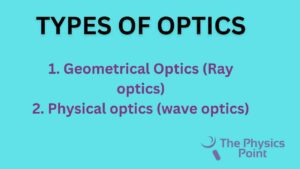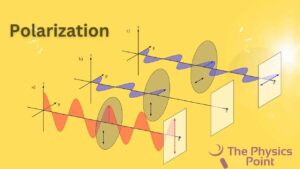What is Optics in Physics? Optics Definition, Types and Importance

Hello readers, how are you? hope you all are fine and doing well. Welcome to our new article, what is optics? Today we will give you deep knowledge about this branch of Physics because this is a very important branch of Physics so you must everyone know about the optics definition. From the competition point of view and Research field area optics as a vast variety of search (What is Optics) and Research ideas. With the help of this article, we will describe to you the parts of optics and the importance of optics. So read our whole article from start to end to get your concepts clear in optics.
Today’s article has many subheadings with respect to optics such as what is optics, Optics definition physics, Optics meaning, What is reflection, What is a reflection, and some brief ideas about polarization. If you want to know the Fundamentals of Physics, you can also understand physics from zero level with the help of our first article on this website. The link is given below the paragraph. So let’s move one hour article without wasting your precious time.
What is optics (Definition)?
Optics is one of the most studied branches of Physics. In this branch of Physics be studied about light and its behavioral properties and the pattern the light follows. Light Is of different types but visual or visible light Is absorbed and emitted energy in the form of tiny particles known as photons. Photon has no rest mass and it has both properties of light of wave nature as well as particle nature. We can say that light has dual properties of waves and particles.
In very simple words we can describe optics that it is a behavior of visible light, ultraviolet and infrared light. Wherever we see everything is possible only due to visible light. The system by which an image is formed is known as the image-forming optical system.
Types of Optics
Optics is divided into two parts – Geometrical Optics and Physical Optics:

1. Geometrical Optics (Ray Optics)
It is also known as geometrical optics and it is a branch of optics in which be studied the propagation of light in terms of rays. Light has many properties and in this branch, we have to study image-forming concepts, mirrors, lenses, Gamma Rays microwaves X-rays, etc. In the understanding of Physics, the term light also indicates the electromagnetic radiations of many different types of wavelengths whether we can see from the naked eye or with the help of any instrument. The very familiar and most common types of properties of light in this branch of optics are refraction and reflection.
Reflection
You must know that reflection occurs at a surface. It happens when light rays come and bounce to the surface at an angle. Reflection describes the way how an image is formed by the polishing surface. The light rays must follow the law of reflection according to which the incident ray angle is equal to the angle of reflection.
Refraction
Refraction is another property of light rays. By the phenomena of refraction, we can understand how lenses form the image of any object. When light travels from one medium to another medium with different refractive indexes its speed is affected by the medium. The technology of optical fibers is based on the concept of refraction.
The refraction law is also known as Snell’s law. This law is indicated by –
n1 sinθ1 = n2 sinθ2
Here n1 and n2 indicate the refractive index of two different mediums.
θ1 and θ2 are the angles created by light rays in respect of the normal or perpendicular line.
2. Physical optics (wave optics)
Physical optics is also known as wave optics. In this branch of optics, light is considered a wave. Here the light behaves and interacts with objects in a waveform that have wavelengths nearly closer or smaller than the wavelength of light. Wave optics explain different types of optical phenomena like diffraction, interference, and the polarization of light.
Interference
Interference describes as the superposition of two waves that forms a resulting wave that may be smaller or larger than the parent (original) wave. If the resulting wave is larger than the original waves, it is known as constructive interference. Constructive interference happens when two waves on the same phage combined with each other and formed a wave with an amplified amplitude. If the resulting wave is smaller than the original waves, it is known as destructive interference. Interactive interference happens when two waves of out of phage superimpose to each other and create a wave with a smaller amplitude or sometimes maybe with zero amplitude.
Diffraction
Through the diffraction phenomena, we understand the concept of the bending of light when it is passing through an opening path or an obstacle. In diffraction the smaller the slate the more extreme diffraction is produced. You all may have observed the phenomena of diffraction on the CD or DVD disc surface. It means you observe the rainbow pattern formed on the disc of a CD or DVD. This rainbow formation is a result of diffraction.
Polarization
Polarization is also one of the defining properties of light that depict the wave oscillation’s direction with respect to the direction of propagation of the wave. The light polarizes in the direction parallel to the vibrations of the electric field.

Importance of Optics
This branch of physics – what is Optics, is very important because with the help of optics, we can understand the concept of light and we are able to see anything around us. Many disorders related to the vision of the eye are nearly curable with the help of lenses by the help of the branch Ray optics. Optics also allow us to do research on new topics in a wide range of electromagnetic waves and modern physics.
The Conclusion
In today’s article, you have learned many things about what is optics in physics. Hope you all guys understand the concepts of optics and very well know the types of optics and the importance of optics. Further, if you have any queries or any suggestions related to the article you can use the comment section for your precious suggestions at the last of the article. If you found this article on what is optics, more useful, you can share this with your friends also. Now it’s time to take leave. Very soon we will meet again with a new topic of Physics. Thank you!
